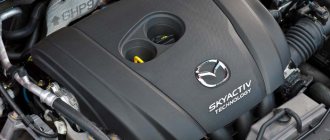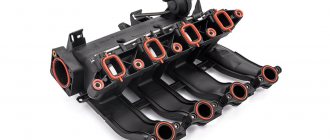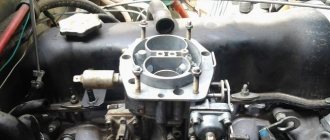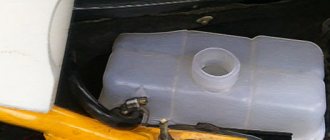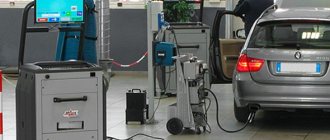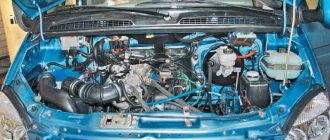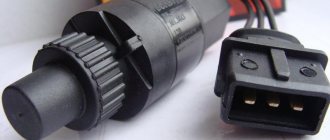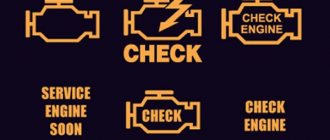Even taking into account the fact that cars equipped with a carburetor are an outdated solution, such cars continue to be popular in the CIS and are firmly established in the lower price segment. At the same time, the relatively simple power system of a carburetor engine requires special attention and needs regular maintenance.
This approach makes it possible to achieve stable operation of the internal combustion engine in different modes, as well as reduce fuel consumption and exhaust toxicity levels. Next, we will look at the main malfunctions of the power supply system of engines with a carburetor, which usually arise during vehicle operation.
Engine power system with carburetor: features and problems
As you know, a car internal combustion engine, regardless of the type of engine and type of fuel (carburetor, injection, gasoline or diesel), runs on a mixture of fuel and air.
Air is “sucked in” by the engine from the atmosphere, and fuel is supplied from the fuel tank through the fuel lines due to the operation of the fuel pump (mechanical or electric). The so-called fuel-air working mixture consists of fuel and air, which are mixed in strictly defined proportions. Then the working mixture is burned in the cylinders.
On certain engines, fuel supply and mixture formation can also be implemented in different ways. In injection engines (except engines with direct injection), fuel is first supplied to the intake manifold through injectors, after which it is mixed with the air there. The mixture then enters the combustion chamber.
In a diesel engine, fuel is injected directly into the combustion chamber, where pre-supplied, compressed and heated air is already located. By the way, a diesel engine has the most complex fuel system.
Currently reading
Installation and repair of the muffler resonator
How often to change the timing belt on a car: what you need...
For this reason, diagnosing the power supply system of a diesel engine is an important and responsible procedure, since the overall service life of such engines greatly depends on the proper operation of the diesel power system.
- If we talk about a carburetor, this is the simplest mechanical metering device; a carburetor engine has external mixture formation. This means that a ready-made working mixture of fuel and air enters the cylinders. The preparation of the air-fuel mixture occurs in the carburetor, where both fuel and air are supplied.
As a rule, carburetors are mechanical devices, that is, the design does not involve the active use of electronic components. The only exceptions can be considered only certain later developments, which are actually transitional devices from a carburetor to a monoinjector. Such carburetors contain separate electronic actuators.
Let's return to the “classic” version. It would seem that the simplicity of the mechanical mixture formation system eliminates certain disadvantages that are inherent in electronic solutions. In other words, reliability is increased. However, in practice, one can only partially agree with this, since carburetors often fail, especially if the owner does not pay the necessary attention to this element.
For a better understanding, let's look at the main elements in the carburetor design:
- the device has a float chamber, which is responsible for the fuel level in the carburetor.
- There are also jets and emulsion tubes, the presence of which allows you to calculate the amount and dose air and fuel.
- The design should also include a diffuser, which is a tube (this tube has a narrow part). At the moment when the throttle valve opens, the air flow rate in the diffuser sharply increases, which allows fuel to be sucked into the engine cylinders.
Malfunctions of the power supply system of carburetor engines and diagnostics
Please note that such a system requires regular adjustment and maintenance. The fact is that if the carburetor does not work correctly (for example, there is a popping sound, it “shoots” at the carburetor) or there is a violation of the mixture formation, this will affect the operation of the internal combustion engine.
As a result, the engine may begin to twitch, power and traction are lost, the power unit does not pick up speed, unstable operation at idle and/or difficulty starting when cold or hot is possible, fuel consumption increases, the engine smokes, etc.
- First of all, in order to understand whether repair of the power supply system of a carburetor engine is necessary, one should rule out problems with the air supply to the carburetor (airing, contamination of the air filter). You also need to check the integrity of the fuel lines, the condition of the fuel filter, the quality of the fuel in the tank, the condition of the gas tank, and the functionality of the gas pump.
- If everything is in order with these elements, the fuel is clean and of high quality, and checking the ignition system did not reveal anything, then you need to diagnose the carburetor.
First, you need to check the tightness of the carburetor connection and all its gaskets, fittings, etc. Then you can proceed to removing the device and disassembling it. At the initial stage, in some cases it is enough to clean the carburetor. This procedure is performed using a special carburetor cleaner. We also add that such cleaning should be performed 1-2 times a year for preventive purposes. - If cleaning does not solve the problem, then it is necessary to disassemble the carburetor and clean or replace the jets separately.
Then the carburetor is adjusted. As a rule, such an adjustment involves setting the fuel level in the float chamber, as well as adjusting the idle speed. We also recommend reading the article on how to choose a carburetor for a VAZ classic. From this article you will learn about which carburetor to choose for classic VAZ models.
Normally, the fuel level should be 18-19 mm below the plane of the housing connector and the float chamber cover. The level is checked through the hole in the float chamber body, which is closed with a plug. To adjust the level, in some cases it is necessary to change the thickness of the gaskets that are located under the needle valve in the float chamber.
As for adjusting the idle speed on the carburetor, such settings are made using a thrust screw that limits the closing of the throttle valves (mixture quantity screw) and two screws that allow you to change the composition of the working mixture of fuel and air (quality screws).
Diagnostics of faults in the fuel system of gasoline engines
I will try to explain it in such a way that even a schoolchild can understand it.
The fuel system consists of: a gas tank, a fuel pump, fuel lines, a fuel filter, a fuel rail (fuel rail, distribution line, ...) with injectors and a fuel pressure regulator. The latter can easily be called a “check valve”, because It is he who releases the excess pressure in the bar (read - on the injectors), forced by the fuel pump, into the return line - the fuel line, which takes the “excess” gasoline back to the fuel tank.
To create the necessary pressure on the nozzles, naturally, the system must be “closed” on both sides of them. On one side it is closed by a valve, which is part of the fuel pump (sometimes it can be replaced separately, sometimes not), and on the other side by a fuel pressure regulator.
If, after a long period of parking, the car does not start the first time, this often indicates a drop in pressure in the fuel system.
This can be explained quite simply - if one of the valves malfunctions, gasoline returns back to the gas tank over some time and the engine simply does not have enough fuel to start. When the ignition is turned on (even before the engine starts), the fuel pump is turned on for a few seconds to pump fuel into the rail. Therefore, if the pressure in the system drops and it is impossible to start the engine, it is often possible to “catch up” the pressure required to start the engine to the bar by turning on the ignition “several times for a few seconds.” If after this the engine starts without problems, this indicates a malfunction of one of the valves.
We need to make a reservation right away: In this case, we mean that the fuel lines are sealed. Otherwise, you would probably see a puddle of gasoline under the car or at least smell it.
We also do not consider damage to the fuel pump (the housing has burst). In all my practice I have never seen a single case like this, although theoretically anything is possible.
So, in order for us to accurately identify the cause of the malfunction, we just need to measure the fuel pressure in the system. This is done very simply. To work, you need a “set for measuring pressure in fuel systems.”
Even the simplest and most inexpensive kit has a sufficient set of hoses and adapters for almost any engine.
Then everything is according to the instructions:
1. Remove the hose from the supply
(pos. 12) and connect the pressure gauge to the gap.
Instead of poses. 16 or between 16 and 12. 2. Create pressure in the bar (with the ignition key as described above). 3. Turn off the ignition, remember (write down) the value. 4. We look at the pressure gauge - naturally, the pressure begins to drop. It may be immediate, but most likely you will have to wait a while. 5. Shut off the return - securely clamp the hose - pos.
13. 6. Create pressure (point 2), remember (write down) the value. 7. Turn off the ignition. 8. We look at the pressure gauge (if the pressure does not start to drop immediately, wait 30-40 minutes to be sure). If the pressure no longer drops , the fuel pressure regulator is at fault. If the pressure continues to drop , the fuel pump valve is at fault.
In principle, this is enough - the culprit has been found and there is no need to read further...
To fully verify that the fuel pump valve is faulty, let’s do one more experiment:
9. Create pressure (point 2), remember (write down) the value. 10. Shut off the supply (item 12) after the pressure gauge (between the pressure gauge and the fuel rail, item 1).
If the pressure drops , the fuel pump valve is at fault.
If there is a suspicion that the injectors are leaking, then this can be easily checked without any pressure gauges. Simply unscrew the fuel rail from the engine and pull it out towards you along with the injectors. Turn on the ignition and see what happens to them. At the same time, you can see which nozzle is spraying normally and which one is pouring - turn the starter.
And finally... From experience I will say that for a hundred replacements of a faulty fuel pressure regulator, there are only 2-3 replacements of the fuel pump valve (pump assembly). This is explained quite simply - the fuel pump valve is often nothing more than an ordinary ball valve, and it is located in the fuel tank, and therefore is well cooled. The pressure regulator, in turn, has a more complex device, and in addition it is installed above the engine, and therefore is exposed to high temperatures.
© golgofa, 2015
When is it necessary to diagnose the power supply system of a carburetor engine?
It is necessary to diagnose the system in the following cases:
- Formation of a lean or rich combustible mixture. You can determine its characteristics by simply turning out the spark plugs. If black carbon deposits are visible on the electrode and on the skirt, then the mixture is rich, if white, then it is poor.
- Unstable operation of the carburetor engine at XX speed. There can be a lot of reasons - from clogged jets to malfunction of the fuel pump.
- Presence of traces of gasoline on the fuel line elements. This indicates a violation of their integrity and air entering the system, which leads to disruptions in the operation of the internal combustion engine.
First signs of trouble
If your car does not start the first time (it growls treacherously), and also maintains high engine speeds when the engine is warm, it is possible that when stopping at traffic lights, the engine speeds fluctuate or run erratically - this is a signal to contact a service station to check the internal combustion engine control system. You shouldn't skimp on this.
Otherwise
, if you do not diagnose and fix it in time, you may end up having to overhaul the motor or even replace it.
If the nearest service station is several tens or even hundreds of kilometers away, you can conduct self-diagnosis.
To do this, you need to check the stage of contamination of the air filter.
, if everything is fine with it, check the operation of the fuel pump. To do this, disconnect the fuel supply hose from the injector rack and turn the engine with the starter; if fuel does not flow, there is a malfunction, either in the power supply system to it or the pump itself has failed.
And the last parameter for self-testing a malfunction of the power supply system in an injection engine is the presence of wire breaks on the plugs when connecting to the injectors.
Having carried out all the above steps, nothing was found to identify the malfunction. Tow the vehicle to the station using either a tow truck or another vehicle. For safety reasons, you should not carry out repair work yourself, but rather entrust this painstaking work to professionals.

